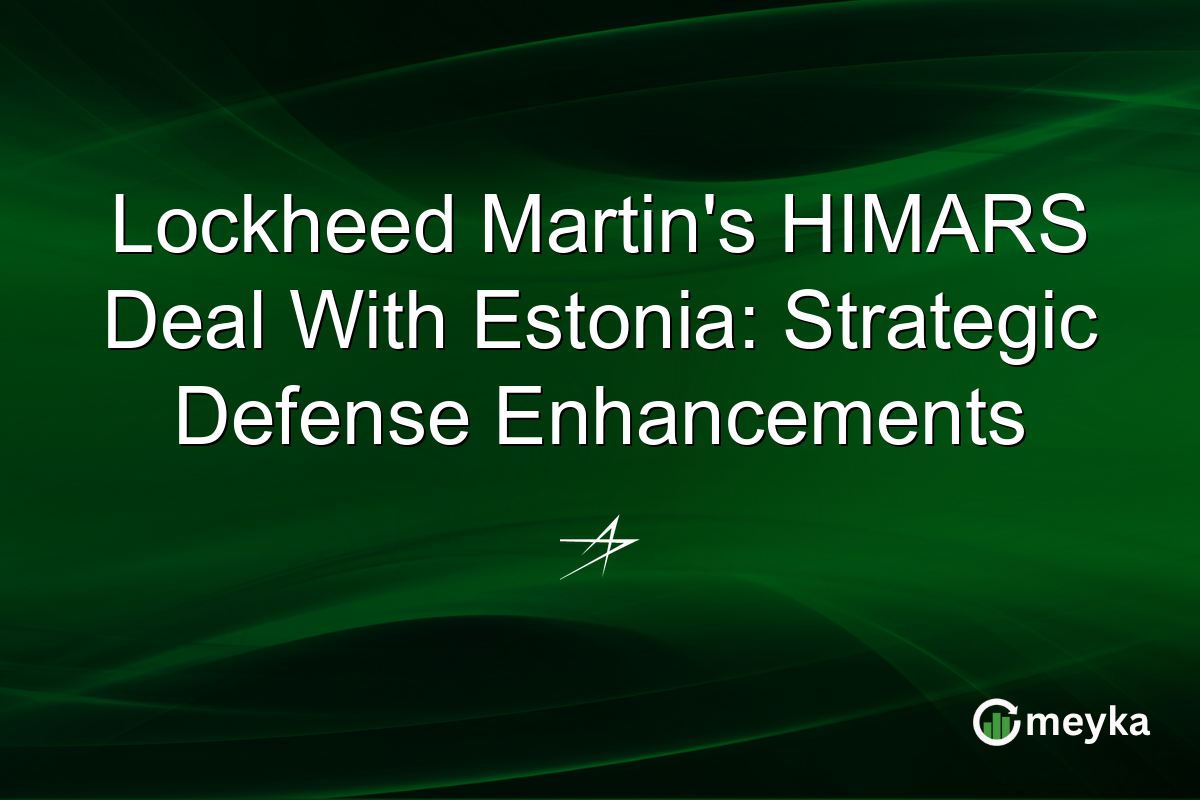Estonia’s recent move to enhance its defense capabilities with the acquisition of additional HIMARS units from Lockheed Martin underscores the Baltic nation’s strategic focus on security amid regional tensions. The deal is significant in the context of the ongoing conflict in Ukraine and evolving security dynamics in the Baltic region. By securing these advanced artillery systems, Estonia aims to bolster its military readiness and deter potential threats, aligning with a broader defense strategy that prioritizes modernization and regional cooperation.
Overview of the HIMARS Estonia Deal
The recently announced HIMARS Estonia deal underscores a critical aspect of Estonia’s defense strategy. The acquisition of additional High Mobility Artillery Rocket System (HIMARS) from Lockheed Martin highlights Estonia’s commitment to strengthening its military capabilities. Designed for rapid deployment and precision strikes, HIMARS systems provide Estonia with a formidable artillery option crucial for regional security within the Baltic context. This move complements Estonia’s broader defense initiatives aimed at modernizing its armed forces and increasing interoperability with NATO allies.
Estonia’s defense ministry has emphasized the importance of these systems, pointing to their role in enhancing national security amid increased geopolitical tensions. With delivery expected between 2028-2029, strategic planning is underway to integrate these systems efficiently into Estonia’s military infrastructure. This indicates a long-term approach to defense preparedness.
More insights can be found in this article: breakingdefense.com/2025/11/estonia-proceeding-with-second-himars-buy-eyeing-28-29-delivery.
This strategic acquisition demonstrates Estonia’s proactive stance in addressing security threats, emphasizing its position within the Baltic and European defense framework.
Baltic Security and Regional Implications
The HIMARS deal has significant implications for Baltic security, a region facing heightened tensions due to the ongoing conflict in Ukraine. Estonia’s decision to enhance its defense capabilities is a direct response to regional security challenges, emphasizing collective defense strategies within NATO.
These developments come as the Baltic states increase military collaboration to ensure security against potential aggression. Estonia’s integration of HIMARS into its defense architecture not only strengthens its own military capabilities but also enhances deterrence through cooperative defense strategies with Latvia and Lithuania.
This shows a clear alignment with NATO’s strategic goals, particularly in countering perceived threats from Russian military activities in Eastern Europe. The deployment of HIMARS in Estonia will serve as a deterrent, bolstering security and stability across the region while fostering unity within the alliance.
Impacts on Lockheed Martin and Market Sentiment
Lockheed Martin’s contract to supply Estonia with HIMARS units reflects positively on the company, reinforcing its position as a leading defense supplier. As of now, Lockheed Martin (LMT) trades at $460.78, showing a recent decline of 1.36% over the day. However, the company holds a B+ stock grade with a neutral rating from analysts, suggesting a stable outlook amidst a volatile market environment.
The Estonian deal likely bolsters investor confidence in Lockheed Martin’s continued growth in the European market. The company’s earnings announcement on January 27, 2026, will provide further insights into the financial impact of international sales, including deals such as with Estonia, on its overall performance.
For investors focusing on defense stocks, the rising demand for high-tech military solutions, such as HIMARS, highlights a positive trend. This enhances Lockheed’s revenue opportunities in light of global defense spending increases, particularly within NATO allies.
Estonian Defense Strategy: A Broader Perspective
The HIMARS acquisition fits into Estonia’s broader defense strategy, which prioritizes modernization and collaboration. As Estonia seeks to enhance its military capabilities, investments in organizational training and technological upgrades remain pivotal.
This purchase aligns with Estonia’s defense policies, aimed at integrating cutting-edge technology with existing military assets. By doing so, Estonia increases its deterrence capabilities, ensuring rapid response potential in the event of regional conflicts.
Moreover, this strategy reflects Estonia’s commitment to upholding Baltic stability and maintaining robust defensive ties with Western allies. This approach also demonstrates Estonia’s proactive engagement in regional security dialogues, ensuring its role as a reliable partner within the NATO framework.
For further perspectives, readers could explore detailed analyses at estonianworld.com.
Final Thoughts
Lockheed Martin’s HIMARS deal with Estonia signifies a pivotal step in strengthening Baltic security amid evolving geopolitical dynamics. As Estonia enhances its defense capabilities, it not only boosts its own military preparedness but also contributes to regional stability and NATO’s strategic defense objectives.
From Lockheed Martin’s perspective, this contract underscores the company’s pivotal role in global defense strategy, capitalizing on increased demand for advanced military technologies among NATO allies. This offers investors opportunities amidst growing defense sector investments.
For Estonia, the acquisition of HIMARS units represents a significant investment in national and regional security, exemplifying a commitment to modernization and collaboration. As the Baltic region braces for ongoing challenges, such strategic decisions ensure resilience and readiness, supporting peace and stability in a complex geopolitical landscape.
FAQs
The HIMARS deal strengthens Estonia’s defense capabilities, enhancing military readiness and deterring potential threats. It aligns with NATO strategies and bolsters regional security in the Baltic area, crucial amid heightened geopolitical tensions.
HIMARS provides rapid deployment and precision strike capabilities, crucial for modern defense strategies. It enhances Estonia’s artillery range and effectiveness, integrating well with NATO’s defense framework to ensure regional security.
The HIMARS deal reinforces Lockheed Martin’s position as a leading defense supplier. Although its stock currently shows slight declines, the deal supports long-term growth, particularly in European markets. Investors see this as a strategic opportunity amidst defense spending increases.
Disclaimer:
The content shared by Meyka AI PTY LTD is solely for research and informational purposes.
Meyka is not a financial advisory service, and the information provided should not be considered investment or trading advice.
